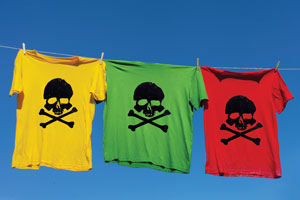|
|
|
Killer Clothes!
by Drs. Brian Clement & Anna Maria Clement
 There is danger lurking in something that people touch every day,
but give little thought to -
their clothing. There is danger lurking in something that people touch every day,
but give little thought to -
their clothing.
An estimated 8,000 chemicals are employed to transform raw materials into clothes, according to The Ecologist magazine.
This process involves bleaching, dyeing, scouring, sizing and finishing the fabrics.
Synthetic clothing now commonly contains such toxins as formaldehyde, brominated flame retardants, and perfluorinated chemicals like Teflon fibers to give trousers, skirts and other apparel "non-iron" and "non-wrinkle" durability. Perfluorinated compounds, it should
be pointed out, are classified as cancer causing agents under U.S. Environmental Protection Agency guidelines.
Important things to know about clothing:
- BRAS: There are strong correlations between the use of bras and breast lumps
or cysts, which are thought to be precursors to breast cancer. Evidence showing a link between bras and breast cancer emerged
in 1991 from a study of breast size and
breast cancer risk by researchers in the
Department of Epidemiology at the
Harvard School of Public Health. Published
in the European Journal of Cancer, this survey of thousands of women found
that, "Premenopausal women who do not wear bras had half the risk of breast cancer compared to bra users."
- SYNTHETIC CLOTHING: Studies show that synthetic undergarments can warp male sexuality and diminish fertility. Synthetic clothing also poses dangers regarding fire safety. So much so that the commanding general of the Marines in Iraq ordered his troops in 2006 to stop wearing synthetic fabrics any time they went off-base. Medical studies also show that synthetic fibers, conventionally used for athletic clothing, actually inhibit athletic performance. This is because the electrostatic field emission from the clothing affects muscle fibers in the body. Synthetic materials also "off-gas" from
the day they're made until the day they're thrown away. They release minute amounts of chemicals that are absorbed through the skin and lungs. These toxic fumes can cause cancer and neurological disorders.
- COTTON (nonorganic): 25% of all the pesticides used on our planet are sprayed onto cotton crops. For this reason, people should always choose organic cotton or other organic natural fibers.
- "EASY CARE,CLOTHING: No-iron or stain resistant shirts and pants are often sprayed with formaldehyde. While many countries enforce strict regulations only enforces regarding formaldehyde, the United States "voluntary" standards, with no levels or limits stated.
- LAUNDRY'S DIRTY SECRET: An analysis of laundry wastewater, both industrial and from public
laundromats, performed a few years ago by the Environmental Working Group, detected a range of hormone-disrupting contaminants being released. Phthalates, used to stabilize fragrances, are hormone disruptive chemicals commonly added to detergents and other cleaning products.
- FIRE RETARDANT: Many nations require infant's clothing to be sprayed with flame retardant chemicals. This is among the deadliest clothing treatments and is directly linked with tumor growth and mental illness. Of course, babies are the most sensitive to these kind of toxic materials.
The best immediate changes one can make:
- Buy only natural fiber clothing as you buy new clothes, especially for your children and babies.
Good options are cotton, flax, hemp, silk, wool and linen. Less common natural fiber options include alpaca, angora, camel, cashmere, mohair, ramie and saluyot.
- Buy only organic clothing when possible, certainly organic undergarments, since the reproductive organs are among the areas most sensitive to toxins.
- Steer clear of "Easy Care" and flame retardant clothing.
- Start getting rid of synthetic clothing you've accumulated.
From toxic chemicals like formaldehyde and phthalates to insecticides, flame retardants, and nano-partides, synthetic clothing today contains a toxic stew of dozens of substances that pose a threat to
both human and environmental health.
The preceeding article is based on the book, Killer Clothes! How Seemingly Innocent Clothing Choices Endanger Your Health ... and how to protect yourself reveals in
detail the toxic truth about the clothes we wear and the surprising number of harmful effects on health caused by garments once considered safe. This is a well-documented expose that the clothing and chemical industries would rather you never learned
about, and reveals which fabrics and clothes contribute to breast cancer, infertility, and a range of diseases - and which garments are safe to wear. All based on medical science studies, these studies, for too long, have been hidden from public awareness. Available in the Hippocrates store. Call (561) 471-8876, ext. 171 or visit www.Hippocrateslnstitute.org.
Co-authors Dr. Brian Clement and Dr. Anna Maria Clement are co-directors of the internationally-renowned Hippocrates Health Institute (HHI). They have created wellness and disease prevention programs followed by more than 300,000 people who have attended HHI, as well as millions
more world-wide who employ the institute's teachings. They have also authored over two dozen books on natural health antidotes to illness and disease.
|

